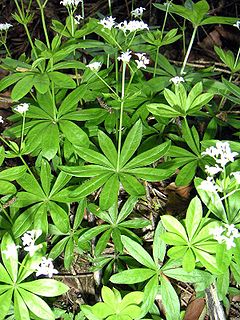
Galium odoratum
Background Information
This Schools selection was originally chosen by SOS Children for schools in the developing world without internet access. It is available as a intranet download. Before you decide about sponsoring a child, why not learn about different sponsorship charities first?
| Woodruff | |
|---|---|
 |
|
| Woodruff plant in flower | |
| Scientific classification | |
| Kingdom: | Plantae |
| Division: | Magnoliophyta |
| Class: | Magnoliopsida |
| Order: | Gentianales |
| Family: | Rubiaceae |
| Genus: | Galium |
| Species: | G. odoratum |
| Binomial name | |
| Galium odoratum (L.) Scop. |
|
| Synonyms | |
|
Asperula odorata |
|
Woodruff (Galium odoratum) is a herbaceous perennial plant in the family Rubiaceae, native to Europe, North Africa and western Asia. It grows to 30-50 cm (12-20 ins.) long, often lying flat on the ground or supported by other plants. The plant is also known in English as Sweet Woodruff or Wild Baby's Breath. "Master of the woods" is probably a translation of the German name Waldmeister. Names like "Sweetscented bedstraw", "Cudweed" and "Ladies' Bedstraw" should be avoided; the former two properly refer to Galium triflorum, the latter to Galium verum.
The leaves are simple, lanceolate, glabrous, 2-5 cm long, and borne in whorls of 6-9. The small (4-7 mm diameter) flowers are produced in cymes, each white with four petals joined together at the base. The seeds are 2-4 mm diameter, produced singly, and each seed is covered in tiny hooked bristles which help disperse the seed by sticking temporarily to clothing and animal fur.
This plant prefers partial to full shade in moist, rich soils. In dry summers it needs frequent irrigation. Propagation is by crown division, separation of the rooted stems, or digging up of the barely submerged perimeter stolons.
Uses
Woodruff, as the scientific name odoratum suggests, is a strongly scented plant, the sweet scent being derived from coumarin.This scent increases on wilting and then persists on drying, and woodruff is used in pot-pourri and as a moth deterrent. It is also used, mainly in Germany, to flavour May wine (called "Maiwein" or "Maibowle" in German), beer ( Berliner Weisse), brandy, sausages, jelly, jam, a soft drink ( Tarhun), ice cream, and a herbal tea with gentle sedative properties.
High doses can cause headaches, due to the toxity of coumarin. Very high doses of coumarin can cause vertigo, somnolence or even central paralysis and apnoea while in a coma. Since 1981, woodruff may no longer be used as an ingredient of industrially produced drinks and foodstuffs in Germany; it has been replaced by artificial aromas and colorings.


